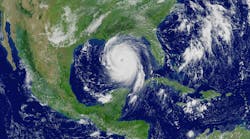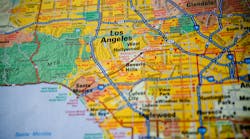Climate change—and the higher volumes of rainfall it brings—is pressuring cities to change their approach to stormwater management. And while it’s not the only urban center in the U.S. thinking about stormwater resiliency, New York City has one of the most detailed plans to handle current and future flooding. Mandates and disasters pushed city departments, namely the Department of Environmental Protection (DEP), to problem solve with a suite of interventions. While some work around attributes that are unique to the city, other resiliency plans face challenges that crop up in most municipalities.
Compared to other interventions, the Bluebelt program is one of the city’s older resiliency tactics. The first creation of engineered Bluebelt waterways debuted in the 1990s. Since then, the DEP has modified about 10,000 acres of Staten Island into Bluebelt systems—or wetlands created by artificial structures on land that used to hold natural streams. In the 1970s, a development boom supplied large numbers of homes with septic systems. Other regional plans filled in natural shorelines to build sewers, and the aggregate land modifications in the borough led to serious flooding hazards. Bluebelt treatment areas have seen better drainage thanks to installations like forebays and step pool systems that collect and slow stormwater before it settles into detention basins.
To become a Bluebelt, a former wetland needs enough elevation changes to facilitate collecting and draining runoff and proximity to an MS4 system. The suite of conditions exists mostly in the southern two thirds of Staten Island, said Charles Olson, chief of the Bluebelt unit for the DEP. Nevertheless, the NYC DEP wants to expand Bluebelts elsewhere. The size of the projects—one recently-completed $64 million endeavor is about nine acres— can sometimes require purchasing undeveloped private lots. In some areas, buying a plot of land could theoretically be the more cost-effective flooding mitigation choice. To help traditional sewers handle flood waters, “you have to rip up all the streets all the way to the ocean,” Olson said, “whereas if you can create some storage locally, you may not have to upsize the sewers.” However, it should be noted that the city currently has no plans to purchase developed parcels to build Bluebelts.
Unlike Bluebelts, green infrastructure can squeeze into slivers of available land, making these interventions another useful tool for the city. The small projects are also mandatory. A 2012 consent order between the state and the NYC Department of Environmental Protection requires the city to reduce storm runoff with green infrastructure. Thousands of these installations should cut 1.67 billion gallons of CSO come 2030, or about 7% of current CSO volumes, according to DEP plans.
The DEP has concentrated on green infrastructure on right-of-way in watersheds with histories of flooding problems. Design choices include bioswales, permeable pavement and retention basins, though options that withstand a truck hopping a curb on a tight turn have gained popularity. Between 2012 and early 2022, the city spent $1.09 billion in capital funds on these projects.
Years of construction lie ahead of the department. In 2021, the DEP calculated that operating green infrastructure assets can cut 507 million gallons of CSOs per year. And even once hen the initial installations are done, the city will have to maintain each one. The DEP is training the necessary workforce while learning how to keep the projects in good condition. These growing pains are common enough in other cities that the EPA has labeled maintenance as one of the largest barriers preventing green infrastructure development.
Green infrastructure also factors into a third and newer resiliency strategy in New York City. Called cloudburst management, the approach is named for what it handles: A sub-daily, intense rain event. Meteorology has used the term “cloudburst” for decades, though what kind of rain events it describes varies around the world, said Bernice Rosenzweig, an earth scientist at Sarah Lawrence College. Copenhagen was one of the earliest cities to design landscapes to accommodate these weather events. New York City turned to the Danish capital for advice on how to do the same in 2015.
Accommodations for rainfall-related flooding typically rely on data about daily volumes—not high quantities in a short period, Rosenzweig said. As a result, conventional flood hazard mapping strategies are often inadequate for cloudburst planning. Instead, designs need combined hydrologic and hydraulic modeling, or analysis that determines how much water from a given storm becomes runoff and the speed, depth and locations the surplus will reach.
“It's extraordinarily computationally expensive, and it's also very data dependent,” Rosenzweig said. “Very few cities have the extremely high resolution digital surface models that are needed to do this type of modeling.”
The NYC DEP put hydraulic models to work while assessing possible cloudburst management plans for a patch of Queens in 2017. In 2022, the designs were either finished or still underway for three different pilot cloudburst management projects, two of which lie in the 2017 study area. Each plan has to “absorb,” “store,” and “transfer” the downpour runoff, according to the DEP. Depending on location, the required capabilities will be met with rain gardens, depressed gutters, stormwater holding tanks under parking lots, and sunken public seating that can collect rainfall.
Plenty more road, gutter, sewer and greenspace renovations lie in New York City’s future. Each one will come with communication challenges as locals ask what is changing around them and why, particularly if pockets of the city morph drastically enough that people can’t use the land as they used to.
“We're going to learn to be a little more respectful and engage in a little bit more stewardship over what we have,” Olson said. “I think these things are just going to have to play out over time.”
Leslie Nemo is a freelance science writer. Nemo can be reached at [email protected].






